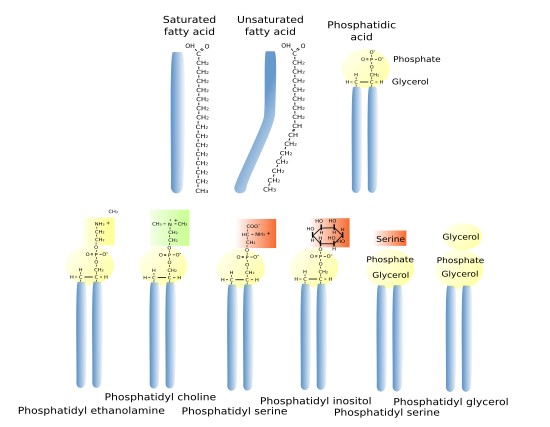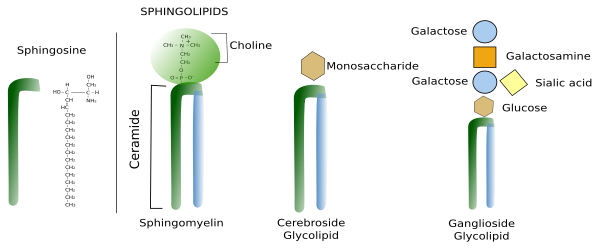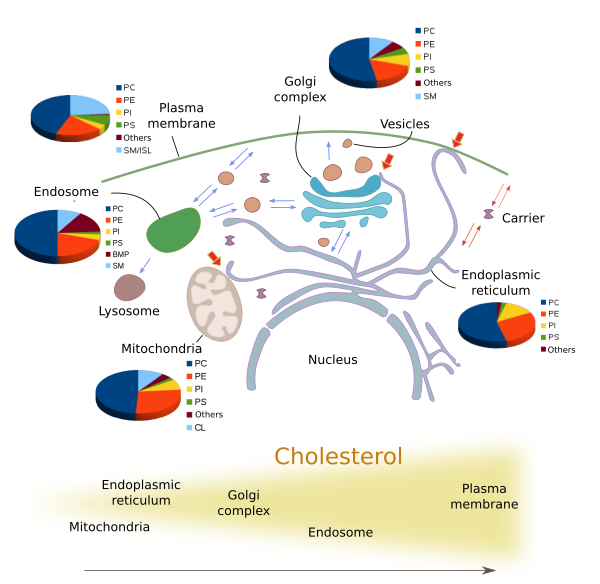The structural organization of cell membranes depends largely on their lipids. Their diversity and spatial organization (as bilayer) make lipids essential for membranes. The physical properties of membranes, such as thickness, fluidity, and asymmetry, depend strongly on the lipid repertory. They also influence the function of membrane proteins, and the molecular interactions between some lipid types led to lateral segregation of spatial and functional membrane domains. In the plasma membrane, lipids contribute to the membrane potential by providing electrical charges at both surfaces of the membrane. Some lipids can also work as second messengers in the cell.
membrane
models
Lipids make up around 50 % of the plasma membrane weight, with about 5 million lipids per µm2. There are more than 1000 types of lipids are distributed through the different membranes of a eukaryotic cell.
Membrane lipids show a hydrophobic domain that forms the inner part of the membrane and a hydrophilic domain toward the aqueous environment that forms the two surfaces of the membrane. That is why they are known as amphiphilic. There are three mayor groups of membrane lipids regarding their structure and molecular composition.
1. Glycerophospholipids or phosphoglycerides
Glycerophospholipids are the most abundant type of lipids in cell membranes. Structurally, they have 3 domains: two fatty acid chains, glycerol, and phosphoric acid (Figure 1). Fatty acid chains are 13 to 19 carbon atoms in length. Most of the carbon-carbon bonds are simple, which are referred to as saturated bonds. However, more than half of the fatty acids contain at least one double carbon-carbon bond, which is referred to as unsaturated. Each double bond makes a permanent bend in the fatty acid chain and makes membranes more fluid. Fatty acids constitute the inner hydrophobic (water phobia or water flee) part of membranes.

Glycerol makes a bridge between the two fatty acid chains and also binds a phosphoric acid. The phosphoric acid may be linked to a wide variety of molecules, such as ethanolamine, choline, serine, glycerol, inositol, or inositol 4,5-bi-phosphate. They form the hydrophylic domain of the lipid. The names of the different glycerophospholipids derive from these molecules. For example, phosphatidylcholine accounts for more than 50 % of the lipids of the eukaryote membranes.
2. Sphingolipids
Sphingolipids contain a sphingosine and a fatty acid chain. Sphingosine and fatty acid form a molecule known as ceramide (Figure 2 and ↗ ). A variety charged molecules can be linked to ceramide. In this way, sphingolipids show a molecular structure similar to glycerophospholipids: two hydrophobic chains linked to one hydrophilic head. In animal cells, most membrane glycolipids, which are those containing sugar in the hydrophilic domain, are sphingolipids. Sphingomyelins are other type of sphingolipids that contain one ethanolamine or one phosphorylated choline in the hydrophilic domain. Sphingolipids are more abundant in the plasma membrane than in organelles.

3. Sterols
Cholesterol (Figure 3) is the most important sterol in animal cell membranes and the third most abundant type of lipid in the plasma membrane, while it is scarce in membranes of organelles. Cholesterol is located among the fatty acid chains of the other membrane lipids. Non-animal cell contain other types of sterols in their membranes. Sterols influence fluidity, stiffness and permeability of membranes.
4. Lipid proportion in cell membranes
The different membranes of the cell show a distinct lipid composition. The identity of cell organelles and their membranes is determined by their molecules, both lipids and proteins (Figures 4 and 5). These lipid composition differences are maintained even under a constant molecular flux of lipids between organelles.


Several mechanisms have been posed to explain this differential distribution of lipid in cell membranes:
Differential lipid synthesis. The proportion of some lipids is determined by the place they are synthesized. For instance, sphingolipids are assembled in the Golgi complex and therefore are the in post-Golgi compartments where these lipids are more abundant, but they are hardly found in the endoplasmic reticulum. However, this is not a general rule. For example, cholesterol is synthesized in the endoplasmic reticulum, but the amount of cholesterol is higher in post-Golgi membranes
Selective transport. Lipids cannot travel freely through the cytosol because of their hydrophobic fatty acid chain. The lipid transporters are mostly vesicles that carry the lipids as components of their own membranes. There are also proteins that can transfer single lipid molecules between membranes. They take a lipid from a membrane, hide the fatty acid from the aqueous cytosolic environment, diffuse to another compartment and release the lipid molecule into the membrane of this compartment.
Membrane contact sites. At electron microscopy, membranes from different organelles can be observed very close to each other. There are proteins located between these membrane contact sites that transfer lipids between the two membranes, and therefore between the two organelles. Membrane contact sites can be found between organelles that are not directly communicated by vesicles.
Differential degradation and recycling of lipids. All membranes are under a heavy turnover of lipids, either by lipid degradation in situ or by taking them out in vesicles or transporters. Particular lipid species may be selected by these mechanisms, therefore influencing the ratio of lipid types in a membrane or in a membrane domain.
5. Asymmetry
Membrane asymmetry is the differential distribution of lipids between the two lipid hemilayers. We will deal with this membrane feature in this page.
-
Bibliography ↷
-
Bibliography
Bissig C, Gruenberg J. 2013. Lipid sorting and multivesicular endosome biogenesis. Cold Spring Harbour perspectives in biology. 5:a016816.
Janmey PA, Kinnunen PKJ. 2006. Byophisical properties of lipids and dynamic membranes. Trends in cell biology. 16:538-546.
Vance JE. 2015. Phospholipid synthesis and transport in mammalian cells. Traffic. 16:1.
van Meer G, Voelker DR, Feigenson GW. 2008. Membrane lipids: where are they a how they behave. Nature reviews in molecular cell biology. 9:112-124.
-
 Cell membrane
Cell membrane 